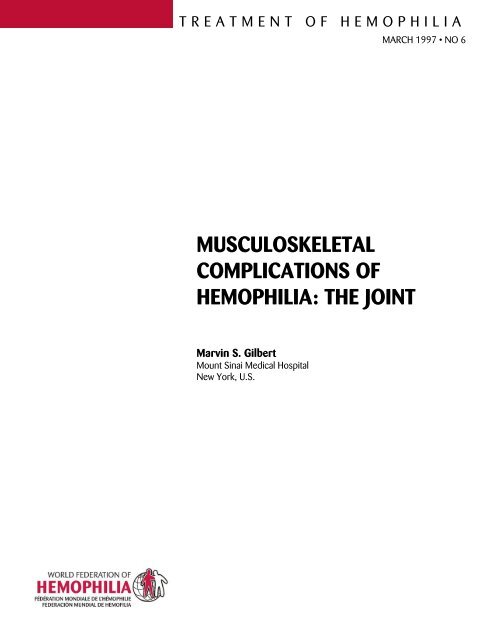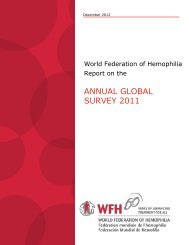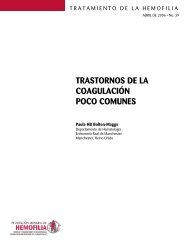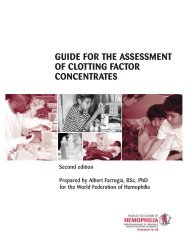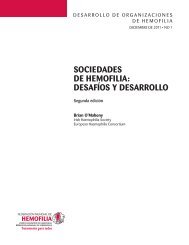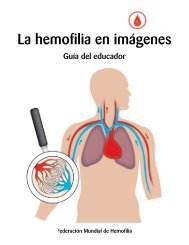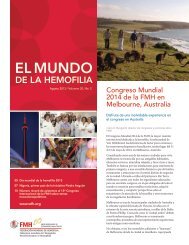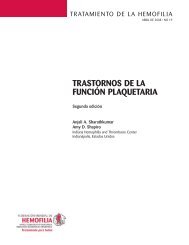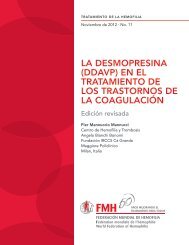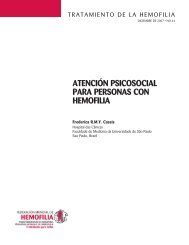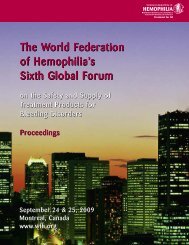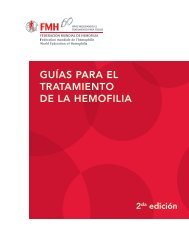musculoskeletal complications of hemophilia: the joint
musculoskeletal complications of hemophilia: the joint
musculoskeletal complications of hemophilia: the joint
You also want an ePaper? Increase the reach of your titles
YUMPU automatically turns print PDFs into web optimized ePapers that Google loves.
TREATMENT OF HEMOPHILIA<br />
MARCH 1997 • NO 6<br />
MUSCULOSKELETAL<br />
COMPLICATIONS OF<br />
HEMOPHILIA: THE JOINT<br />
Marvin S. Gilbert<br />
Mount Sinai Medical Hospital<br />
New York, U.S.
Published by <strong>the</strong> World Federation <strong>of</strong> Hemophilia (WFH)<br />
© Copyright World Federation <strong>of</strong> Hemophilia, 1997<br />
The WFH encourages redistribution <strong>of</strong> its publications for educational purposes by not-for-pr<strong>of</strong>it<br />
<strong>hemophilia</strong> organizations. In order to obtain permission to reprint, redistribute, or translate this<br />
publication, please contact <strong>the</strong> Communications Department at <strong>the</strong> address below.<br />
This publication is accessible from <strong>the</strong> World Federation <strong>of</strong> Hemophilia’s web site at www.wfh.org.<br />
Additional copies are also available from <strong>the</strong> WFH at:<br />
World Federation <strong>of</strong> Hemophilia<br />
1425 René Lévesque Boulevard West, Suite 1010<br />
Montréal, Québec H3G 1T7<br />
CANADA<br />
Tel. : (514) 875-7944<br />
Fax : (514) 875-8916<br />
E-mail: wfh@wfh.org<br />
Internet: www.wfh.org<br />
The Treatment <strong>of</strong> Hemophilia series is intended to provide general information on <strong>the</strong> treatment and<br />
management <strong>of</strong> <strong>hemophilia</strong>. The World Federation <strong>of</strong> Hemophilia does not engage in <strong>the</strong> practice <strong>of</strong><br />
medicine and under no circumstances recommends particular treatment for specific individuals. Dose<br />
schedules and o<strong>the</strong>r treatment regimes are continually revised and new side-effects recognized. WFH<br />
makes no representation, express or implied, that drug doses or o<strong>the</strong>r treatment recommendations in this<br />
publication are correct. For <strong>the</strong>se reasons it is strongly recommended that individuals seek <strong>the</strong> advice <strong>of</strong> a<br />
medical adviser and/or to consult printed instructions provided by <strong>the</strong> pharmaceutical company before<br />
administering any <strong>of</strong> <strong>the</strong> drugs referred to in this monograph.<br />
Statements and opinions expressed here do not necessarily represent <strong>the</strong> opinions, policies, or<br />
recommendations <strong>of</strong> <strong>the</strong> World Federation <strong>of</strong> Hemophilia, its Executive Committee, or its staff.<br />
Treatment <strong>of</strong> Hemophilia Monographs<br />
Series Editor<br />
Dr. Sam Schulman
Musculoskeletal Complications <strong>of</strong> Hemophilia:<br />
The Joint<br />
Marvin S. Gilbert<br />
Orthopedics is <strong>the</strong> medical specialty that deals with afflictions <strong>of</strong> <strong>the</strong> locomotor system, that is<br />
to say, disorders <strong>of</strong> <strong>the</strong> bones, <strong>joint</strong>s, muscles and peripheral nerves. It is <strong>of</strong> interest that <strong>the</strong><br />
word orthopedics has no direct relationship to any <strong>of</strong> <strong>the</strong>se structures, but is derived from <strong>the</strong><br />
Greek “ortho” (straight) and “pedia” (child). Literally, <strong>the</strong> word means “straight child”. It is<br />
in <strong>hemophilia</strong> that it is most appropriate in that <strong>the</strong> orthopedist is asked to straighten <strong>the</strong> bent<br />
limbs <strong>of</strong> <strong>the</strong> child. However, because <strong>of</strong> hematological advances <strong>of</strong> <strong>the</strong> past decade, it has<br />
become our aim to prevent <strong>the</strong> child from ever becoming bent, to keep <strong>the</strong> child straight so<br />
that he or she can participate in all <strong>the</strong> normal activities <strong>of</strong> his or her peers.<br />
In <strong>the</strong> early 1800s, arthritic <strong>joint</strong>s were reported in persons with <strong>hemophilia</strong>, but it was not<br />
until 1868 that Volkmann stated that in <strong>hemophilia</strong> "bleeding into <strong>joint</strong>s occurred ei<strong>the</strong>r<br />
spontaneously or following minimal trauma." In 1892, König, an orthopedic surgeon,<br />
attempted to operate on several affected knees, but was not able to control bleeding by<br />
surgical means alone. The demise <strong>of</strong> <strong>the</strong><br />
patients allowed him to study <strong>the</strong> <strong>joint</strong> and<br />
he was <strong>the</strong> first physician to show that <strong>the</strong><br />
arthritis associated with <strong>hemophilia</strong> is<br />
directly linked to bleeding into <strong>the</strong> <strong>joint</strong>.<br />
The orthopedic community seemed to<br />
abandon <strong>hemophilia</strong> following König's<br />
failures until <strong>the</strong> 1950s when Henry Jordan<br />
tried to stop bleeding and correct<br />
contractures with casts and braces. In <strong>the</strong><br />
1960s, factor replacement became reality<br />
and many orthopedic interventions,<br />
including physical <strong>the</strong>rapy, surgical tendon<br />
leng<strong>the</strong>ning, <strong>joint</strong> replacement and<br />
arthroscopy could be used to alleviate <strong>the</strong><br />
effects <strong>of</strong> past bleeding. The challenge <strong>of</strong><br />
<strong>the</strong> next century is to prevent any <strong>of</strong> <strong>the</strong>se<br />
<strong>musculoskeletal</strong> <strong>complications</strong> from ever<br />
occurring.<br />
Normal Knee Joint<br />
Illustration by Bernard P. Woschek
The Acute Bleeding Joint (Acute Hemarthrosis)<br />
The most common sites <strong>of</strong> bleeding in <strong>hemophilia</strong> are <strong>the</strong> <strong>joint</strong>s and muscles <strong>of</strong> <strong>the</strong> arms and<br />
legs. The vast majority <strong>of</strong> bleeding occurs into <strong>the</strong> <strong>joint</strong>s <strong>of</strong> <strong>the</strong> extremities, although bleeding<br />
may occur into most any <strong>joint</strong>. There appears to be a predilection for large <strong>joint</strong>s, namely <strong>the</strong><br />
ankles, knees, hips, elbows and shoulders. Spontaneous bleeding into <strong>joint</strong>s is limited to<br />
persons with severe <strong>hemophilia</strong>. Bleeding may occur following trauma in patients with mild<br />
and moderate <strong>hemophilia</strong>. Clinical manifestations <strong>of</strong> factor VIII and factor IX deficiency are<br />
indistinguishable.<br />
I would like to point out why bleeding occurs into <strong>the</strong> <strong>joint</strong> cavity and <strong>the</strong> reasons that <strong>the</strong><br />
characteristic arthritis termed "hemophilic arthropathy" develops following recurrent bleeding<br />
into <strong>the</strong> <strong>joint</strong>.<br />
König pointed out that <strong>the</strong>re were three clinical stages to <strong>the</strong> development <strong>of</strong> hemophilic<br />
arthropathy. He termed <strong>the</strong> first <strong>the</strong> “recurrent bleeding” stage. Following this, <strong>the</strong>re is an<br />
inflammatory response and he termed this <strong>the</strong> panarthritis stage. The third and last stage he<br />
called <strong>the</strong> fibrosis stage and contracture commonly known as arthritis. He was able to point<br />
out that bleeding is not a common manifestation <strong>of</strong> <strong>the</strong> last stage.<br />
Margaret Swanton followed a series <strong>of</strong> hemophilic dogs and in 1959, she described <strong>the</strong><br />
natural history <strong>of</strong> bleeding into a <strong>joint</strong>. A diffuse hematoma first develops in <strong>the</strong> synovium<br />
which eventually extends into <strong>the</strong> <strong>joint</strong> cavity. Following reabsorption <strong>of</strong> <strong>the</strong> bleeding, <strong>the</strong>re<br />
is an inflammatory response in <strong>the</strong> synovial tissue. This causes <strong>the</strong> tissue to swell and become<br />
filled with blood vessels. Recurrent bleeding <strong>the</strong>n occurs and <strong>the</strong> synovium begins to produce<br />
enzymes which cause fur<strong>the</strong>r inflammation within <strong>the</strong> <strong>joint</strong>. Eventually <strong>the</strong> bleeding causes<br />
destruction <strong>of</strong> <strong>the</strong> synovium and it is replaced with scar tissue. This is referred to as fibrosis.<br />
However, following <strong>the</strong> bleeding, <strong>the</strong> iron that is left deposited in <strong>the</strong> <strong>joint</strong> and <strong>the</strong> enzymes<br />
that are produced by <strong>the</strong> synovium begin to cause changes in <strong>the</strong> smooth cartilage that lines<br />
<strong>the</strong> end <strong>of</strong> <strong>the</strong> bones. The cartilage breaks down and becomes roughened. These changes<br />
eventually result in an arthritic and destroyed <strong>joint</strong>.<br />
The clinical picture <strong>of</strong> <strong>joint</strong> bleeding is characterized by pain, swelling and limitation <strong>of</strong><br />
motion. Frequently <strong>the</strong> patient states that he knows he is bleeding prior to any <strong>of</strong> <strong>the</strong>se<br />
findings. This period has been termed <strong>the</strong> “aura”. It may be accompanied by mild stiffness<br />
and sometimes <strong>the</strong> patient describes a feeling <strong>of</strong> tightness or tingling. It is believed that this<br />
corresponds to <strong>the</strong> time when <strong>the</strong> bleeding is limited to <strong>the</strong> synovium. Once <strong>the</strong> bleeding fills<br />
<strong>the</strong> <strong>joint</strong>, it becomes warm, swollen and tense. Limitation <strong>of</strong> motion and secondary muscle<br />
spasm follow. When treatment is started early, <strong>the</strong> bleeding will stop quickly and <strong>the</strong><br />
symptoms may recede quickly. However, it is very common for <strong>the</strong> symptoms to resolve<br />
slowly and at times <strong>the</strong> bleeding may recur despite what seems to be adequate treatment.<br />
A <strong>joint</strong> that displays a tendency towards recurrent bleeding has been termed a "target <strong>joint</strong>" by<br />
Aronstam. Once a target <strong>joint</strong> is established, complete resolution is possible, but more<br />
commonly <strong>the</strong>re is a slow response to treatment and arthritis will develop.<br />
2
No <strong>joint</strong> hemorrhage is so minor that treatment may be deferred or postponed, and no plan <strong>of</strong><br />
treatment is complete unless it includes replacement <strong>of</strong> <strong>the</strong> missing clotting factor to a level<br />
sufficiently high to stop <strong>the</strong> bleeding. This level must be maintained long enough to stop <strong>the</strong><br />
bleeding and to prevent recurrence. At <strong>the</strong> present time, episodic replacement <strong>the</strong>rapy is <strong>the</strong><br />
mainstay <strong>of</strong> treatment in <strong>hemophilia</strong>. Most spontaneous hemarthroses respond to a single<br />
infusion <strong>of</strong> factor VIII or factor IX, which achieves a level <strong>of</strong> 30% to 40%. If swelling or<br />
spasm is present, treatment to levels <strong>of</strong> 50% is usually required and <strong>the</strong> infusions may have to<br />
be repeated at 12- to 24-hour intervals. Many patients are on programmes <strong>of</strong> home care.<br />
Follow-up for minor bleeding episodes that respond to a single infusion <strong>of</strong> factor can be left<br />
to <strong>the</strong> discretion <strong>of</strong> <strong>the</strong> educated and motivated person or family with <strong>hemophilia</strong>, but<br />
physician evaluation is required if <strong>the</strong> <strong>joint</strong> <strong>of</strong> bleeding does not respond within 12 to 24<br />
hours.<br />
Minor hemarthroses may not require immobilization, but some individuals find relief from<br />
elastic bandages, foam rubber splints or slings. Some people find that ice helps in <strong>the</strong> relief <strong>of</strong><br />
pain. Severe hemarthroses, in which <strong>the</strong>re is swelling, spasm or infection <strong>of</strong> <strong>the</strong> <strong>joint</strong>, should<br />
be treated with splinting in a position <strong>of</strong> comfort. Prefabricated splints, bulky compression<br />
dressings, or home-made plaster splints can be used. Attempts at correcting <strong>the</strong> deformity<br />
should be deferred until bleeding has been stopped; this will be discussed in <strong>the</strong> next section.<br />
Rest is required for resolution <strong>of</strong> <strong>the</strong> acute symptoms, but, in <strong>the</strong> long run, rest will lead to<br />
limitation <strong>of</strong> motion and muscle atrophy. Therefore, <strong>joint</strong> rehabilitation must be started as<br />
soon as possible, beginning with isometric exercises. As soon as <strong>the</strong> acute symptoms subside,<br />
muscle streng<strong>the</strong>ning and range <strong>of</strong> motion exercises must be started.<br />
Bleeding into <strong>the</strong> <strong>joint</strong> does result in pain. Analgesics may be required to alleviate this and<br />
should be carefully monitored by <strong>the</strong> treating physicians. Any aspirin-containing compound is<br />
contraindicated because <strong>of</strong> <strong>the</strong> risk <strong>of</strong> fur<strong>the</strong>r bleeding due to inhibition <strong>of</strong> platelet function.<br />
Intramuscular injections should be avoided. The use <strong>of</strong> narcotics may be required when <strong>the</strong><br />
pain is severe, but indiscriminate use must be discouraged because <strong>of</strong> <strong>the</strong> chronic nature <strong>of</strong><br />
<strong>the</strong> bleeding and <strong>the</strong> risk <strong>of</strong> addiction. Oral steroids have been shown to decrease <strong>the</strong><br />
inflammatory processes associated with bleeding and are used at many <strong>hemophilia</strong> centers.<br />
Despite <strong>the</strong> well-known <strong>complications</strong>, few problems have been associated with <strong>the</strong>ir use for<br />
three to four days following an acute bleeding episode. Recommended regimens include<br />
Prednisone, 1 to 2 mg/kg/day, for three to four days. Non-steroidal anti-inflammatory<br />
medications (NSAIDS) have not proven very beneficial in decreasing <strong>the</strong> acute inflammatory<br />
reaction and probably should be avoided in acute bleeding episodes because <strong>of</strong> <strong>the</strong>ir<br />
inhibition <strong>of</strong> platelet function and <strong>the</strong> potential to enhance bleeding. Their judicious use,<br />
however, may be helpful in controlling arthritic pain and will be discussed in <strong>the</strong> next section.<br />
Aspiration or removal <strong>of</strong> blood from <strong>the</strong> <strong>joint</strong> with a syringe and needle can be considered.<br />
Theoretically, <strong>the</strong> early removal <strong>of</strong> blood from <strong>the</strong> <strong>joint</strong> should result in a more rapid response<br />
to treatment and should be beneficial in delaying or eliminating <strong>the</strong> development <strong>of</strong> arthritis.<br />
The disadvantages are that <strong>the</strong> patient must ei<strong>the</strong>r come to a physician's <strong>of</strong>fice or to a hospital<br />
3
emergency room. A secondary problem is that young children will frequently delay reporting<br />
a hemarthrosis to <strong>the</strong>ir parents because “<strong>the</strong>y don't want to be stuck with a needle in <strong>the</strong><br />
<strong>joint</strong>”. The definite indications for aspiration include: (1) a tense and painful <strong>joint</strong> which has<br />
not responded to factor replacement within 24 hours; (2) pain which seems out <strong>of</strong> proportion<br />
to <strong>the</strong> physical or clinical findings; (3) evidence <strong>of</strong> neurovascular or skin compromise; and (4)<br />
a <strong>joint</strong> in which <strong>the</strong> pain pattern is unusual or <strong>the</strong>re is an elevated temperature. The last<br />
criterion requires that a septic <strong>joint</strong> be ruled out.<br />
Contraindications to aspiration include <strong>the</strong> presence <strong>of</strong> an inhibitor that cannot be controlled<br />
and local factors, such as an open wound or infected overlying skin. When aspiration is<br />
performed, it should be done at <strong>the</strong> time <strong>of</strong> factor replacement when levels <strong>of</strong> 50% are<br />
achieved. A large bore needle, at least 16-gauge, should be used as small clots frequently clog<br />
smaller needles. Immobilization with a plaster splint or compression dressing helps relieve<br />
symptoms and may prevent recurrent bleeding. A second infusion <strong>of</strong> factor, 12 to 24 hours<br />
after <strong>the</strong> aspiration, is frequently recommended.<br />
The importance <strong>of</strong> physical <strong>the</strong>rapy and <strong>the</strong> role <strong>of</strong> <strong>the</strong> <strong>the</strong>rapist must be stressed. The aim is<br />
to increase function by maintaining range <strong>of</strong> motion, increasing muscle strength, and avoiding<br />
<strong>joint</strong> deformity. Prophylactic factor replacement may be required if <strong>the</strong> pain and swelling<br />
have not completely resolved. If <strong>the</strong>re is any concern, factor replacement should be used prior<br />
to <strong>the</strong> first few physical <strong>the</strong>rapy sessions. After a week or two, <strong>the</strong> exercises are usually<br />
continued by <strong>the</strong> patient without factor replacement. These exercises should be done at home<br />
on a regular basis. The programme <strong>of</strong> <strong>the</strong>rapy should be individually tailored by <strong>the</strong> physical<br />
<strong>the</strong>rapist to <strong>the</strong> patient's needs and lifestyle.<br />
The Chronic Swollen Joint (Recurrent Bleeding and Synovitis)<br />
If <strong>joint</strong> bleeding is not adequately treated, it tends to recur. The inflamed, swollen synovium<br />
bleeds more easily than normal synovium and causes fur<strong>the</strong>r swelling and inflammation. This<br />
vicious cycle must be broken to prevent <strong>the</strong> iron within <strong>the</strong> blood and <strong>the</strong> enzymes from<br />
destroying <strong>the</strong> cartilage, leading to <strong>the</strong> development <strong>of</strong> arthritis.<br />
Synovitis or recurrent bleeding can be differentiated from an acute hemarthrosis in that <strong>the</strong><br />
swelling does not respond to a single infusion <strong>of</strong> factor. The <strong>joint</strong> is less painful than with an<br />
acute hemarthrosis and <strong>the</strong> range <strong>of</strong> motion is frequently not limited. It must be remembered<br />
that cartilage has a limited ability to repair itself. The synovitis may not be painful, but <strong>the</strong><br />
destruction is insidious and cumulative and, <strong>the</strong>refore, <strong>the</strong> condition must be treated as<br />
vigorously as a painful hemarthrosis.<br />
Prophylaxis, or preventative replacement <strong>of</strong> <strong>the</strong> missing clotting factor, for three to six<br />
months is indicated. The intermittent use <strong>of</strong> steroids helps reduce <strong>the</strong> inflammation within <strong>the</strong><br />
<strong>joint</strong>s. A dose <strong>of</strong> 1 mg/kg/day <strong>of</strong> Prednisone for one week should be followed by a dose <strong>of</strong> .5<br />
mg/kg/day for a second week. If <strong>the</strong> synovitis is recalcitrant, <strong>the</strong> course may be repeated in<br />
three to six weeks.<br />
4
Aspiration may be useful initially to control <strong>the</strong> swelling with <strong>the</strong> <strong>joint</strong> and should be<br />
undertaken after prophylaxis has been started but before steroids are used. Immobilization is<br />
useful at times but must be used in conjunction with physical <strong>the</strong>rapy to prevent atrophy and<br />
loss <strong>of</strong> range <strong>of</strong> motion.<br />
A lack <strong>of</strong> response <strong>of</strong> <strong>the</strong> recurrent bleeding <strong>of</strong> synovitis after three to six months <strong>of</strong><br />
prophylaxis and treatment is usually considered an indication for more aggressive<br />
intervention. Open surgical synovectomy, arthroscopic synovectomy and radioactive<br />
synovectomy should <strong>the</strong>n be considered. The indications and management <strong>of</strong> <strong>the</strong>se procedures<br />
will be considered in a later monograph.<br />
The Arthritic Joint (Hemophilic Arthropathy)<br />
Despite early and what seems to be adequate treatment, <strong>the</strong> progression <strong>of</strong> bleeding and<br />
synovitis to arthropathy have not been eliminated. Only prophylactic replacement <strong>of</strong> <strong>the</strong><br />
missing clotting factor started soon after <strong>the</strong> first bleeding episode holds promise <strong>of</strong> doing<br />
this, but it is not economically or medically feasible in most parts <strong>of</strong> <strong>the</strong> world. To minimize<br />
<strong>the</strong> consequences <strong>of</strong> an hemarthrosis which has not responded or cannot be adequately treated<br />
with factor replacement, short-term immobilization should be considered. This can lead to<br />
fur<strong>the</strong>r deformity. Isometric exercises should be started immediately and should quickly<br />
progress to more vigorous streng<strong>the</strong>ning exercises and range <strong>of</strong> motion exercises.<br />
For recalcitrant <strong>joint</strong>s, <strong>the</strong> temporary use <strong>of</strong> braces and splints have proven beneficial. A<br />
prefabricated sports brace can be useful. They usually have a hinge that can be locked and<br />
opened to allowed progressive motion, especially at <strong>the</strong> knee. A molded ankle-foot orthosis<br />
will frequently control pain and bleeding at <strong>the</strong> ankle. High shoes and orthoses can be<br />
inexpensive and have been used to minimize foot and ankle problems. Temporary splinting<br />
may be used to control pain and bleeding at <strong>the</strong> elbow, but long-term use is not feasible as it<br />
interferes with function. Again I must stress that physical <strong>the</strong>rapy must be used in conjunction<br />
with all forms <strong>of</strong> splinting.<br />
If a flexion contracture has developed at <strong>the</strong> knee, cast correction is indicated. Serial casting,<br />
wedge casting and <strong>the</strong> use <strong>of</strong> desubluxation-type hinges have been successful in correcting<br />
<strong>the</strong>se contractures. Serial casting can be used on an outpatient basis. Wedge casting works<br />
more quickly but usually requires that <strong>the</strong> patient be admitted to <strong>the</strong> hospital. A desubluxation<br />
hinge is used if <strong>the</strong>re is any evidence <strong>of</strong> posterior subluxation or if <strong>the</strong> contracture is greater<br />
than 45º. Following correction, <strong>the</strong> patient is kept in a brace until physical <strong>the</strong>rapy has<br />
streng<strong>the</strong>ned <strong>the</strong> muscles around <strong>the</strong> knee, especially <strong>the</strong> quadriceps. This usually takes three<br />
to six months.<br />
5
The Future<br />
Until now, <strong>the</strong> role <strong>of</strong> <strong>the</strong> orthopedic surgeon in <strong>the</strong> care <strong>of</strong> <strong>the</strong> person with <strong>hemophilia</strong> has<br />
been to correct <strong>the</strong> ravages <strong>of</strong> bleeding into <strong>the</strong> <strong>joint</strong>s, muscles and o<strong>the</strong>r structures in <strong>the</strong><br />
extremities. It has become obvious that <strong>the</strong> only way to prevent <strong>musculoskeletal</strong> problems is<br />
to correct <strong>the</strong> hematological defects; <strong>the</strong>se forms <strong>of</strong> relief will come from <strong>the</strong> hematologist<br />
and <strong>the</strong> geneticist. Until <strong>the</strong>n we must work to maintain <strong>the</strong> normal function <strong>of</strong> <strong>the</strong> hemophilic<br />
<strong>joint</strong> and, by utilizing some <strong>of</strong> <strong>the</strong> principles outlined in this paper, it is hoped that <strong>the</strong><br />
children throughout <strong>the</strong> world will be able to keep a “straight” stature.<br />
6


